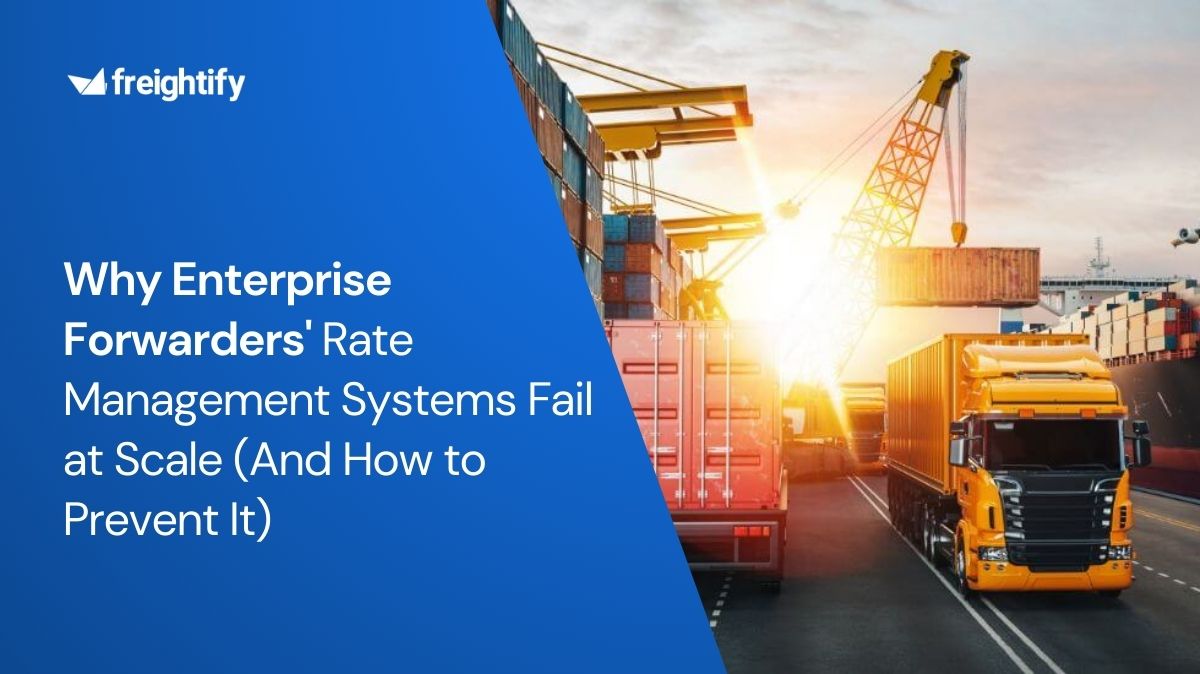Introduction Freight rates fluctuate constantly due to factors like fuel prices, market demand, and geopolitical events. For instance, spot rates were 5% higher in November 2024 compared to the previous year, marking the most significant year-over-year increase since February 2022.
To navigate these challenges, freight forwarders must adopt effective rate management strategies that leverage both industry insights and advanced technology.
What is a Freight Rate Management? Freight rate management involves the systematic process of analyzing, negotiating, and optimizing shipping costs across various transportation modes. In a volatile market, logistics companies must manage rates efficiently to maintain cost-effectiveness and competitiveness.
Let us help you with your journey
Your One Stop Solution to Manage Spot, Contract rates & Margins!
Best Practices for Freight Rate Management Implementing best practices in freight rate management enables logistic providers to optimize costs and operational efficiency. Key strategies include: effective negotiation, fostering strong carrier relationships, utilizing freight rate indexes, and digitizing contract management.
1. Using Effective Negotiation Strategies Successful freight rate negotiation requires a comprehensive understanding of market dynamics, carrier capacities, and shipping requirements. By analyzing current market trends and historical data, freight forwarders can identify optimal times for negotiations and leverage data-driven insights to secure favorable rates. Flexible shipping schedules, higher volume commitments, and real-time rate analytics enhance bargaining power, ensuring more competitive pricing.
2. Building Strong Relationships with Carriers Establishing and maintaining robust relationships with carriers is vital for securing favorable rates and ensuring reliable service. Open communication, consistent collaboration, and mutual trust foster partnerships that can lead to priority treatment and better pricing. Regular performance reviews with carriers help address issues promptly and strengthen the partnership.
3. Utilizing Freight Rate Indexes Freight rate indexes offer valuable insights against industry pricing trends enabling forwarders to benchmark their rates against industry standards. By monitoring these indexes, companies can decide when to lock in rates or explore alternative shipping options. This proactive approach aids in anticipating market shifts and adjusting strategies accordingly.
4. Digitizing Contract Management Transitioning from manual to digital contract management simplifies agreement handling and rate schedules. Digital platforms provide centralized contract storage, enable easy retrieval, and automated tracking of contract terms and expirations. This reduces administrative burdens, minimizes errors, and ensures compliance with negotiated terms, ultimately leading to more efficient rate management.
Limitations of the Traditional Rate Management Processes Given the manual and sub-optimal nature of the current rate management process, there are multiple challenges that Logistics Service Providers face, as enumerated below:
1. Time required for preparing quotes and offering to customers Considering the numerous data sources and formats, calculating a consolidated quote is a time-consuming process, taking up to three days, depending on the modes involved, the origin/ destination, and the cargo and service type.
In today’s fast-paced era of modern trade and commerce, such delays can spell the difference between winning the business or losing it to a competitor who can quote faster
2. Highly manual task, requiring time and effort Compiling data on various costs and activities to generate a quote involves trawling through masses of disparate data, a highly manual task requiring considerable labor and effort.
The procurement department will have to expend considerable resources and time for each quote, prolonging the average quoting times.
3. High Chances of errors and inaccurate quotes The nature and inherent inefficiency of the manual processes increase the probability of errors and, consequently, the probability of an inaccurate quote.
The implications of such inadvertent errors could be severe, ranging from potential revenue losses due to underquoting or loss of business in case of uncompetitive rates.
4. Availability of the latest information and spot rates In the current volatile global transportation markets, where space is scarce and commands a premium, rates change almost daily. Carriers are quoting spot rates with extremely short validity periods.
This means that rates get outdated in a short span of time, sometimes within a matter of a couple of days, wherefore the procurement team needs to constantly obtain updated costs and rates.
With the manual way of working, it is extremely difficult to keep track of the latest rates and incorporate them while in quotes to customers, thereby increasing the probability of incorrect quotes.
5. Difficulty in standardizing information while preparing quotes The disparate data sources and formats make it difficult to standardize and interpret rate information, which is essential for quoting to the customer. This delays responses to customer inquiries, consumes more time and effort than is necessary, and increases the chances of errors in quoting.
6. Non-standardized quotes make it difficult to compare across vendors When working with multiple vendors providing services of similar scope and nature, rates are an important criterion for evaluating and finalizing vendors.
With the disparity in cost quotes and other contractual terms and data being provided in different formats, it can be extremely difficult to compare between different vendors.
7. Multiple pricing desks in each location, resulting in a lack of control and oversight on process and prices quoted Given the workload and nuances involved in manual rate management processes, companies are compelled to invest in expensive resources across their offices.
This effectively decentralizes the pricing function, leaving the management with little visibility into the overall process and efficiency thereof, thus hampering their control over pricing and impeding their ability to ensure that minimum price/ margin guidelines are adhered to.
Let us help you with your journey
Procure, Manage and Quote freight prices (with ancillary charges) in under 2 minutes!
Key Benefits of a Rate Management System Rate Management systems offer robust functionalities to automate and streamline the process of procuring various costs (from all vendors) and retrieving the relevant costs to offer prompt quotes in response to customer inquiries.
Using a Rate Management System affords a freight forwarder the following benefits:
Timely and accurate quotes Fast processing of complex cost structures across multiple vendors Ensure use of the latest freight rates and surcharge levels Accurately deal with intricacies arising from the usage of multiple non-standardized formats, varied contractual terms, and different currencies involved in international transportation Centralized pricing, enabling monitoring and control over the entire pricing process Considerable savings in terms of labor and effort Faster turnaround time for customer inquiries increases the chances of winning the business Single pricing system, which also offers reporting functionalities, thus enabling management to monitor and evaluate historical data Leveraging Freightify to Manage Freight Rates Freightify’s comprehensive rate management platform streamlines operations by:
Centralizing rate data for easy access and comparison. Automating the quoting process to improve response times. Providing real-time rate visibility to enhance transparency and competitiveness. With increased pricing flexibility and agility, Freightify empowers freight forwarders to optimize their rate management strategies effectively.
For more information, feel free to book a demo with our logistics experts to understand how we make it possible for you. Conclusion Effective freight rate management is essential for logistics companies aiming to maintain profitability and competitiveness in a dynamic market. By implementing best practices such as strategic negotiations, strong carrier relationships, utilization of freight rate indexes, and digitized contract management, companies can achieve significant cost savings and operational efficiency. Leveraging advanced technology platforms like Freightify further enhances these efforts by providing automation and real-time data access, positioning freight forwarders for success in the evolving logistics landscape.




















